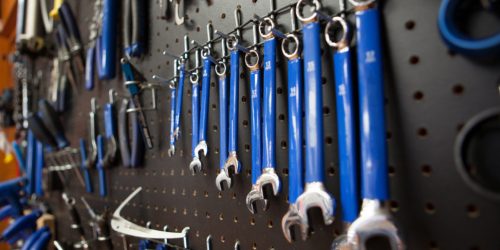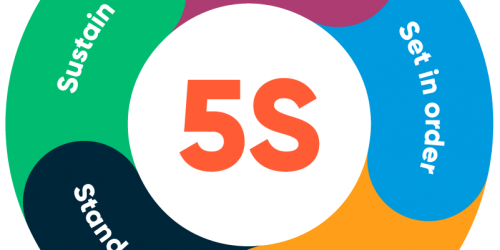The 5 steps towards Lean Management in the workshop
Lean Management is an essential topic within workshops and professionals are particularly concerned about continuous improvement. But how can you apply it directly in the workshop on a daily basis? With the 5S method, of course! Did you know it was invented at Toyota factories in Japan? Adapted to the Western context, it was later renamed Lean Management. Since the 1980s, this simple, effective and very operational management tool has made life easier for operators, maximising safety, and boosting the productivity of companies. It is based mainly on common-sense rules… and a little tenacity. Here’s how to practically apply it in the workshop.
What is Lean Management?
Lean Management is a management philosophy focused on waste reduction. With the aim to add value to the business, this method continuously improves work processes.
By integrating Lean Management principles into the workshop setting, it is possible to create a more harmonious and productive work environment, optimise production flow, and improve the quality of services.
Step 1: Seiri 整理 – Remove the unnecessary to streamline the space
The application of Lean Management philosophy begins with identifying equipment, tools and techniques that add value to the production process.
In the context of a Lean workshop, unnecessary tools and equipment that do not contribute to added value are eliminated. This is one of the fundamental principles of Lean: Focus on value creation and eliminate waste.
Here’s how to proceed:
- Throw away or recycle anything that has not been used in over a year;
- Put away items used less than once a month;
- Tools and equipment used less than once a week should be stored in the workshop;
- Everyday tools should be within easy reach, either directly on the workstation or in an adjoining cabinet.
Step 2: Seiton 整頓 – Easily locate objects
Setting up an efficient storage system in the workshop is another crucial step in a Lean Management approach. Organising tools and equipment rationally and logically improves workflow and increases productivity. Called “Lean Manufacturing”, this method creates a production system that optimises resource use and maximises added value.
“Everything in its place, and a place for everything.” This may not be new, but it is incredibly effective!
To avoid wasting time and energy, consider:
- Choosing rational and logical locations: Small tools at the bottom of the workshop cupboard, larger ones at the top; heavy storage containers at waist height; small objects with hard-to-read labels near a light source, etc.;
- Creating visual storage rules with different colour codes for each use;
- Assigning an obvious place for every object: Dedicated stand, visual indication, etc.;
- Classifying objects: By frequency of use, by order of use, following the First In, First Out method, etc.
Pro tip:
“To immediately find what you’re looking for and avoid mistakes, some manufacturers create furniture whose drawers are different colours: Metrology in yellow drawers, small tools in blue drawers, and red for documentation, etc. You can spot everything at a glance.”
Pascal Bance, Workshop Furniture Product Manager at Manutan.
Step 3: Seiso 清掃 – (Make it) sparkle!
Keeping a clean and well-maintained workspace is essential for ensuring the health and wellbeing of teams. This is an often-overlooked but vital aspect of Lean Management. A clean workshop not only improves the mindset of employees but also the quality of production.
Because a clean space benefits both people and equipment, you should:
- Regularly clean the workshop and furniture, especially when dealing with dirty work;
- Systematically and quickly repair furniture;
- Take care of furniture: Protection (chemical products), maintenance (oil/grease, consumables, etc.);
- Promptly replace damaged and/or obsolete furniture.
Step 4: Seiketsu 清潔 – Standardise workstations and usage rules
Standardising workstations and usage rules is another pillar of Lean Management. Establishing uniform standards for all workshops ensures continuous improvement in quality and productivity.
Additionally, standardisation helps integrate new team members and maintain harmony in the workshop.
To keep these good habits in the long term, it is important to:
- Use a similar organisation, and thus furniture, for all workshops on the site;
- Raise awareness and provide training to employees on the 5S approach;
- Organise and share cleaning and maintenance tasks;
- Display good practices that can impact furniture and organisation.
Step 5: Shitsuke 躾 – Follow the process for continuous improvement
The final step in Lean Management involves following the established process for continuous improvement. This is the essence of Lean thinking, which aims to constantly increase value and reduce waste.
And because the 5S approach is collective by nature, it is crucial to educate teams of the importance of adhering to it:
- By encouraging their efforts;
- By creating collaborative events (furniture inspection, anomaly detection, employee input on layout and future needs, etc.);
- By keeping a logbook on furniture (purchase dates, interventions, lifespan, etc.).
This approach will strengthen commitment to Lean philosophy and ensure that long-term improvements are maintained.
There you have it! Your workshop has never been so organised and serene. Your success will spread to other workshops!
By following the five steps of Lean Management, you can transform your workshop into a more productive, efficient, and harmonious working environment. Not only will this improve the wellbeing of your teams, but it will also increase the added value of your business. It’s time to introduce Lean into your workshop!
And don’t forget, if you need more information or help to choose the appropriate workshop furniture for your needs, you can download our “Workshop Furniture” white paper.





